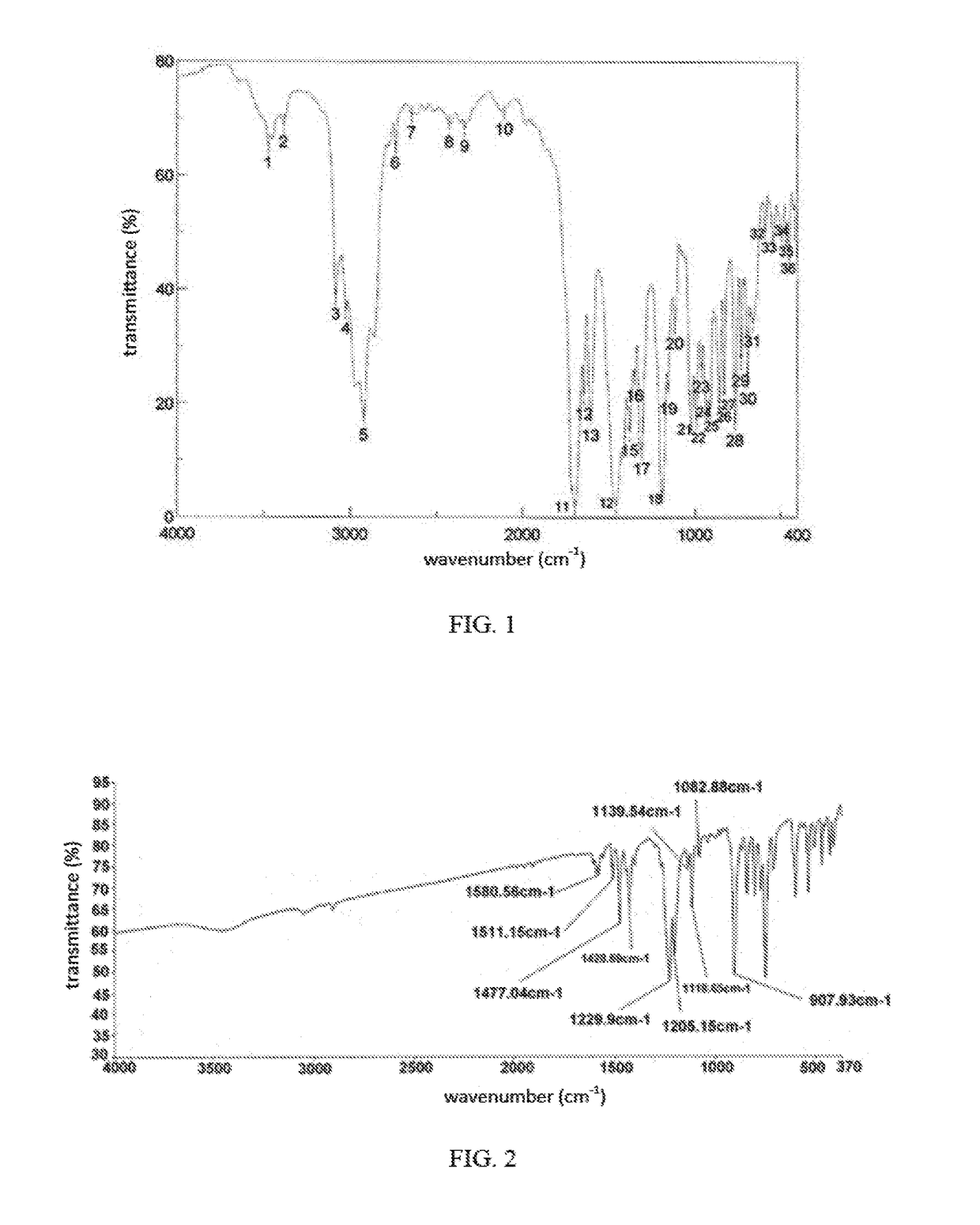Fluorenylidene-diphenol-containing polyphenylene oxide
a technology of fluorenylidene and diphenol, which is applied in the field of polyphenylene oxide resin, can solve the problems that conventional ppos, such as dihydroxy ppo and bis(vinylbenzyl) ppo, still fail to meet the need in us
- Summary
- Abstract
- Description
- Claims
- Application Information
AI Technical Summary
Benefits of technology
Problems solved by technology
Method used
Image
Examples
synthesis example 1
[0120]Add 0.2 mol (400 g) of dihydroxy bisphenol A polyphenylene oxide (SA-90), 0.4 mol (70 g) of α,α′-dichloro-p-xylene, 0.01 mol (3.39 g) of tetrabutylphosphonium bromide and 600 g of toluene into a stirred tank, heat to 75° C. and stir until fully dissolved and well mixed. After heating the well-mixed solution to 95° C., stir for 6 hours; add 1.125 mol (45 g) of sodium hydroxide and 33 g of deionized water, followed by stirring for 6 hours; cool the solution to 70° C., and then add 0.4 mol (140 g) of fluorenylidene-diphenol, followed by stirring for 4 hours, and then cool the reaction solution to room temperature.
[0121]After that, to the cooled reaction solution, add 0.09 mol (8.8 g) of phosphoric acid and 165 g of deionized water, then uniformly mix to allow neutralization, and stand still the solution to allow precipitation. Remove liquid solution other than the precipitate, add 330 g of deionized water and stir, and remove liquid solution other than the precipitate again to co...
synthesis example 2
[0126]Add 0.2 mol (400 g) of dihydroxy biphenyl polyphenylene oxide (OPE), 0.4 mol (70 g) of α,α′-dichloro-p-xylene, 0.01 mol (3.39 g) of tetrabutylphosphonium bromide and 600 g of toluene into a stirred tank, heat to 75° C. and stir until fully dissolved and well mixed.
[0127]After heating the well-mixed solution to 95° C., stir for 6 hours; add 1.125 mol (45 g) of sodium hydroxide and 33 g of deionized water, followed by stirring for 6 hours; cool the solution to 70° C., and then add 0.4 mol (140 g) of fluorenylidene-diphenol, followed by stirring for 4 hours, and then cool the reaction solution to room temperature.
[0128]After that, to the cooled reaction solution, add 0.09 mol (8.8 g) of phosphoric acid and 165 g of deionized water, then uniformly mix to allow neutralization, and stand still the solution to allow precipitation. Remove liquid solution other than the precipitate, add 330 g of deionized water and stir, and remove liquid solution other than the precipitate again to co...
synthesis example 3
e Retardant a
[0131]Mix 216 g of DOPO, 90 g of dichloro-p-xylene and 1200 g of 1,2-dichlorobenzene. Stir and heat the resulting mixture under nitrogen atmosphere at 160° C. to proceed with reaction for 24 hours, followed by cooling to room temperature, filtering, baking and drying under vacuum at 120° C. for 6 hours, thereby obtaining Flame Retardant A as shown below as white powder, wherein the phosphorous content of Flame Retardant A is about 11%.
[0132]Use Fourier transform infrared spectroscopy (FTIR) analysis to characterize Flame Retardant A, and the result is shown in FIG. 2, wherein the FTIR absorption peak appears at 1594 cm−1 (P-Ph), 1205 cm−1 (P═O) and 908 cm−1 (P—O-Ph); the FTIR result indicates the product thus obtained is Flame Retardant A illustrated above.
Example: Property Analysis
[0133]1. Prepregs were Made Using the Resin Compositions Enumerated in Table 1 to 3.
[0134]Resin compositions of E1 to E14 and C1 to C17 were well mixed in a stirred tank individually and then...
PUM
| Property | Measurement | Unit |
|---|---|---|
| temperature | aaaaa | aaaaa |
| wt % | aaaaa | aaaaa |
| particle size | aaaaa | aaaaa |
Abstract
Description
Claims
Application Information
 Login to View More
Login to View More - R&D
- Intellectual Property
- Life Sciences
- Materials
- Tech Scout
- Unparalleled Data Quality
- Higher Quality Content
- 60% Fewer Hallucinations
Browse by: Latest US Patents, China's latest patents, Technical Efficacy Thesaurus, Application Domain, Technology Topic, Popular Technical Reports.
© 2025 PatSnap. All rights reserved.Legal|Privacy policy|Modern Slavery Act Transparency Statement|Sitemap|About US| Contact US: help@patsnap.com



